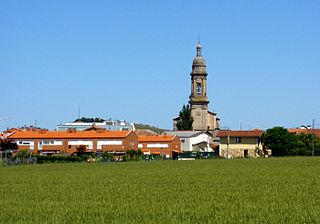Battle of Alegría de Álava
| Battle of Alegría de Álava | |||||||
|---|---|---|---|---|---|---|---|
| Part of First Carlist War | |||||||
|
The town of Alegría-Dulantzi |
|||||||
|
|||||||
| Belligerents | |||||||
|
Carlists supporting |
Liberals (Isabelinos or Cristinos) supporting Isabella II of Spain and her regent mother Maria Christina |
||||||
| Commanders and leaders | |||||||
|
Tomás de Zumalacárregui Manuel Iturralde |
Manuel O'Doyle | ||||||
| Casualties and losses | |||||||
| ~600 | |||||||
Carlists supporting
The Battle of Alegría de Álava (Acción de Alegría de Álava or Batalla de Alegría), a battle of the First Carlist War, occurred on October 27, 1834 at a field in Chinchetru, next to Alegría de Álava (Alegría-Dulantzi), Álava, Spain. It was a Carlist victory.
Carlist forces were led by Tomás de Zumalacárregui, who ambushed Isabeline (Liberal) troops under Manuel O'Doyle.
The Isabeline (Liberal) army under José Ramón Rodil, after a disastrous campaign during the summer of 1834, had attempted to destroy Zumalacárregui’s army and arrest Infante Carlos, Count of Molina. However, Rodil’s forces had been reduced by the Carlists by September 1834. Rodil was forced to give up command to Manuel Lorenzo. Rodil marched towards Madrid, taking with him as escort, as he approached Vitoria-Gasteiz, a division led by O'Doyle, which had belonged to the Liberal Army of Navarre. Rodil, without authorization, placed O'Doyle’s troops under the command of Joaquín de Osma, commander-general of the Basque Provinces and who was based at Vitoria.
The Isabeline troops of Navarre, thus reduced, were unable to keep up with the rapid movements of Zumalacárregui’s army. Zumalacárregui approached the Ebro with the intention of attacking the Riojan place known as Ezcaray, 40 km south of the river. Ezcaray was the site of important factories producing cotton cloths; Zumalacárregui wanted this cloth in order to create winter uniforms for his troops. Zumalacárregui’s scouts explored this area to carry out this plan. Zumalacárregui meanwhile received information on October 20, 1834 that a convoy of arms was traveling from Burgos to Logroño and that it would use the nearby royal road (camino real) as it neared the Ebro.
...
Wikipedia

